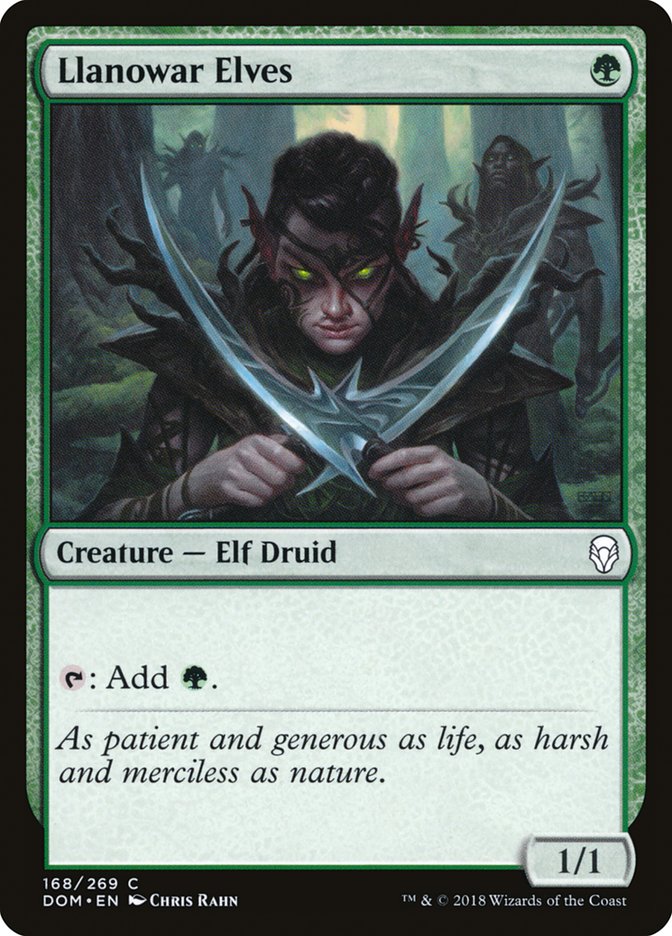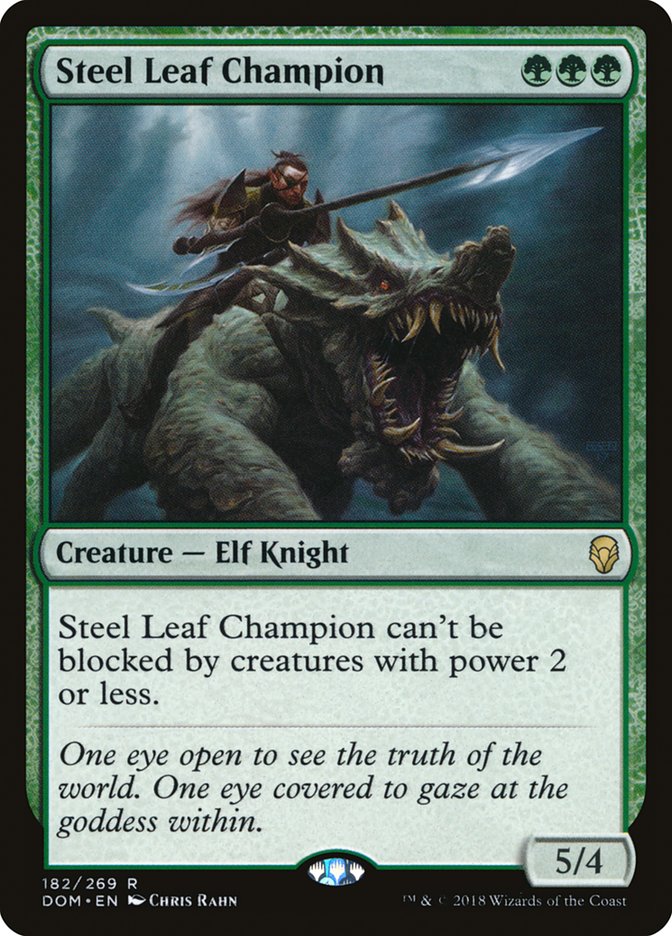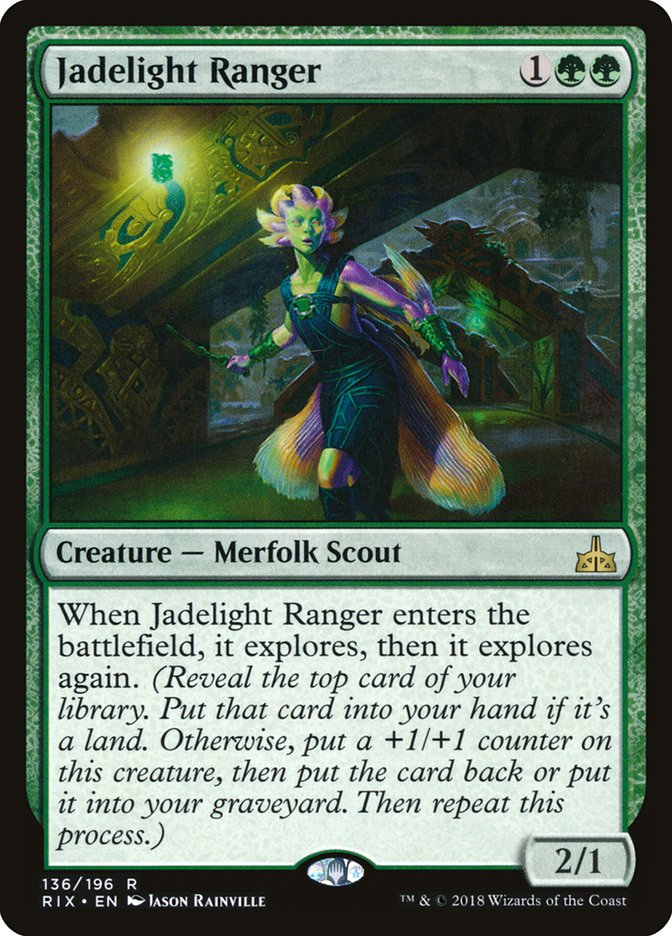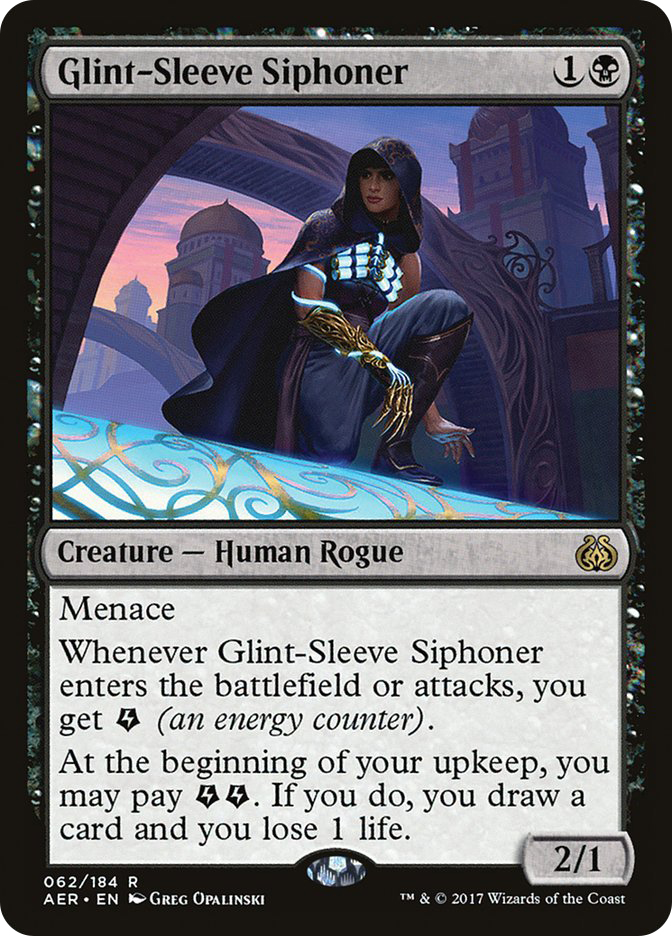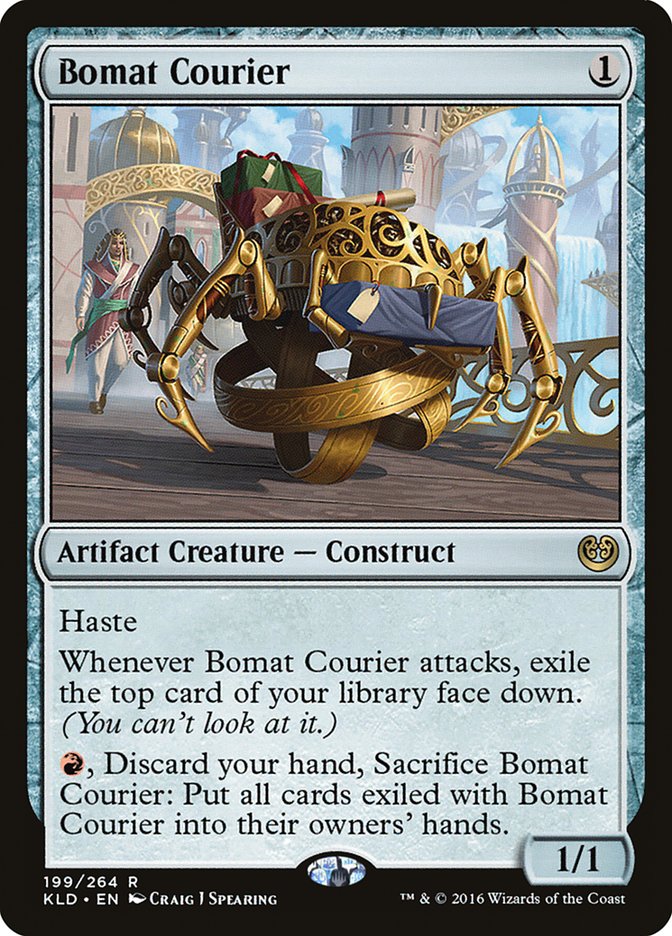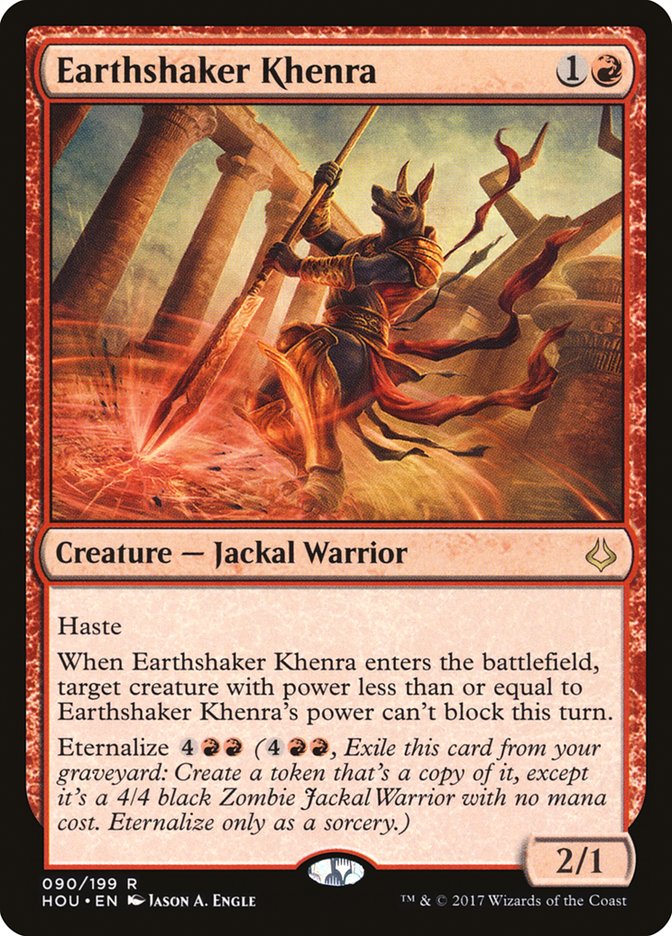This article is slated to go live on Tuesday, two days after the conclusion
of Pro Tour Dominaria. By this time, I’m sure you’ve seen the
numbers: Goblin Chainwhirler comprised roughly 37% of the Day 1 field,
improved to 42% of the Day 2 field and was played as a four-of by seven of
the Top 8 decks. All in all, that’s a lot of chain whirling.
It’s a Goblin eat X/1 world out there.
Look, I’m know you’ve already heard plenty of Goblin Chainwhirler hot
takes. Too good, ban-worthy, yet another format-warping red three-power
three-drop, not even the best card in the red shell, whatever. I’ll spare
you mine, largely because I don’t have one. I’ve been too busy trying to
figure out how to win matches of Standard in this Goblin Chainwhirler
world.
The good news is that the problem is obvious: one-toughness creatures are a
serious liability in this Standard format. The bad news is that figuring
out how to appropriately solve this problem is easier said than done. You
can choose to sidestep the issue entirely by playing a control strategy
that doesn’t want to play one-toughness creatures anyway, but for those of
us who rather like attacking, doing so isn’t an ideal option. No, we have
to answer the hard question: what one-toughness creatures are worth playing
into the certainty of a Chainwhirler-infested metagame?
Two Rules To Fight Chainwhirler By
Right off the bat, let’s dispel the notion that the correct way to fight
Goblin Chainwhirler is to register zero creatures with one-toughness.
Creatures (26)
- 3 Bomat Courier
- 2 Kari Zev, Skyship Raider
- 4 Hazoret the Fervent
- 2 Ahn-Crop Crasher
- 4 Soul-Scar Mage
- 4 Earthshaker Khenra
- 3 Rekindling Phoenix
- 4 Goblin Chainwhirler
Lands (24)
- 24 Mountain
Spells (10)

Wyatt Darby won Pro Tour Dominaria, and he did so with a full
seven one-toughness creatures in his deck. He was playing four copies of
Goblin Chainwhirler himself, so he obviously wasn’t ignorant to the risk he
was taking by playing these one-toughness creatures. He played and won
three Chainwhirler mirrors on his path through the Top 8, so he obviously
wasn’t just lucky, either. Fact is, some one-toughness creatures are still
worth playing, even in the face of the Chainwhirler. But which ones?
Rule 0: For a one-toughness creature to be worth playing, it must
either put you very far ahead in the games where they don’t draw Goblin
Chainwhirler, be pivotally important in non-red matchups, or be a
cornerstone piece of your deck’s plan.
I call this rule the “need a reason” rule, because all it says is that you
need a very good reason to register any one-toughness creature right now.
Honestly, it’s less of a rule and more of a condition of employment. If you
can’t point to a great reason why you need to play a creature vulnerable to
Goblin Chainwhirler, you probably shouldn’t. Such a reason isn’t enough to
lock in a spot on the starting roster, but it’s a necessary starting point
before negotiations can even begin.
Sure, this rule may be obvious, but I think it’s important to establish the
absolute necessities before moving on to the judgment calls. Otherwise,
it’s far too easy to start putting every card you can think of through the
tests you develop. Eventually you’ll find something that technically meets
the criteria you’ve been testing, but still isn’t actually good enough
because the overall power level is too low to bother with. Errors of this
sort end up manifesting as what we call “fancy play syndrome” and can be
avoided altogether by establishing binary baselines before getting into
more complicated analysis.
Alright, so we need a strong reason to want to put said one-toughness
creature in our deck. What next?
Rule 1: When played on curve, one-toughness creatures must provide you
with a tangible reward before falling to a turn three Goblin
Chainwhirler.
Basically, what this rule says is that the fail case for your one-toughness
creature cannot be a complete disaster. If your two-drop dies to a Goblin
Chainwhirler that hits the battlefield the turn after it did and provides
you with no lasting memento of your time together, registering that
two-drop is likely a mistake.
Note that your one-toughness creature doesn’t have to provide you with any
specific amount of reward. They don’t have to fully replace themselves or
deal at least three damage before dying. You just must be able to make any
case whatsoever for your position being improved for their short time on
the battlefield. Of course, the more advantage they can provide you with
the better, but any advantage whatsoever is the barrier for playability
right now.
More on this in a bit, but first, the other rule you should be thinking
about when deciding whether to play with a specific one-toughness creature:
Rule 2: When played off curve, one-toughness creatures must still be
able to meaningfully assist your game plan.
The idea behind this rule is that in the face of Goblin Chainwhirler, you
will often be incentivized to sequence your cards in such a way that your
one-toughness creatures end up being deployed after a potential turn three
Goblin Chainwhirler from your opponent. If your one-toughness creature is
only good on-curve, this isn’t possible, and your creature is inherently
worse against Chainwhirler than one-toughness creatures that are okay with
delayed sequencing.
Now, such sequencing isn’t enough to protect a one-toughness creature from
the Chainwhirler plague. If it were, we wouldn’t be having this discussion
and one-toughness creatures played on turn four would be the order of the
day. But your opponent can always simply draw Chainwhirler on turn four, or
on the turn after you finally deploy your one-toughness creature and ruin
your well-wrought plans. Or they could outplay you and hold their
Chainwhirler until you deploy your vulnerable creatures. Sequencing your
one-toughness creatures later won’t guarantee they dodge Chainwhirler, but
it does make it less likely and having the option to do so when it makes
sense is critically important.
Taken in tandem, these two rules determine which one-toughness creatures
are playable despite the ubiquity of Goblin Chainwhirler and which should
be relegated to sideboards and trade binders. Unlike rule zero, creatures
don’t need to satisfy both rules to be worth registering.
One-toughness creatures that meet one of these conditions are fine to
start, but you’ll probably be looking to sideboard them out after game one.
Drawing them against Goblin Chainwhirler decks won’t lose you the game on
the spot, but drawing too many will and you’d rather not see them at all. I
would cap yourself at playing three or four of these.
Creatures that follow both rules are exactly what you’re looking for. These
cards are far from embarrassing in the face of Goblin Chainwhirler. You can
even leave them in your deck for sideboard games and be happy to draw them!
All that is true, and yet you still shouldn’t play too many.
Losing one creature to a Chainwhirler might be fine but losing multiple at
once represents a tempo swing that’s very hard to recover from. Eight
one-toughness creatures is very likely the maximum right now. That’s just
the way the world is.
Llanowar Elves
Abstract rules are great and all, but they really shine when put into
practice. After all, if they don’t actively help you make decisions when
used, they’re not worth the pixels used to display them on your screen. I’m
not one to start small, so let’s begin by looking at the most contentious
one-drop out there right now.
First, we check rule 0: is Llanowar Elves fundamentally worth playing, and
if so, why? The answer is clearly yes, for all three of the possible
reasons given in the statement of the rule. Llanowar Elves will put you
sizably ahead if they don’t have Chainwhirler, is equally good in nearly
all the non-red matchups, and is generally a huge draw to any deck that
it’s in. Of all the one-toughness creatures in the format, Llanowar Elves
is probably the one with the best reasons to want to play. Rule 0 is
satisfied, with flying colors.
So then, onwards to rule 1. When you’re on the play, you’ll be able to use
Llanowar Elves to add mana to your mana pool twice before Goblin
Chainwhirler comes down. On the draw, only once. One time is more much
worse than two times, but still more than zero times, which is all we
really need. However, adding mana isn’t quite enough on its own to count as
a tangible advantage. We need something to use that mana on.
Here’s where it gets tricky. The advantage Llanowar Elves provides you is
only as good as the card you spend your extra mana on. Getting to cast a
Steel-Leaf Champion a turn early is excellent, and absolutely something you
can hang your hat on and be able to point to in gratitude when it comes
time to say goodbye to your Llanowar Elves. A Jadelight Ranger is
significantly worse, and if things go terribly wrong may even end up
leaving your company at the same time as your Elves. Hard to say you got
much advantage out of that exchange.
But we need to take a step back for a moment. Sure, the advantage Llanowar
Elves gives you is dependent on the card you get to cast with it. Hidden in
there is the following important morsel: you need something to cast for Elves to provide you any advantage.
On its own, Llanowar Elves does not provide you with a significant
tangible advantage before dying to Chainwhirler.
In assuming your Llanowar Elves will help you before dying, you’re giving
yourself credit for having a card to pair it with. Three-drops are what
you’re looking for and Thrashing Brontodon and Steel-Leaf Champion are more
or less the best ones. But you won’t always have one of those cards, and
sometimes when you do they will have the trump to rob you of all advantage:
Soul-Scar Mage. With a Soul-Scar Mage on the battlefield, after the
Chainwhirler dust settles neither Steel-Leaf nor Brontodon will be able to
rumble with the Chainwhirler. In that case, how much advantage did your
Elves gain you, really?
No, they won’t always have the Soul-Scar Mage. But you won’t always have
the three-drop, either. The point here is that your Elves are only as good
as the cards that surround it. You need to play a lot of good
early spells to ramp into for your Elves to pass rule 1. To my mind, the
only deck in Standard that plays a good enough Llanowar Elves is Mono-Green
Aggro. G/B Constrictor is the other notable Llanowar Elves deck, and it
just doesn’t play enough good threes to make Llanowar Elves consistently
provide a tangible advantage through a Chainwhirler.
So Llanowar Elves gets a pass on rule 1 in some decks and a fail in others,
depending on how consistently you can make the early mana meaningfully
matter against the red decks. What about rule 2?
Well, this ones a lot easier to evaluate. Llanowar Elves fails. This
shouldn’t be a surprising development. One of the big weaknesses of mana
creatures historically is that they are extremely anemic top decks later in
the game. You really want to play them on curve, as that’s where you stand
to gain from the extra mana boost they provide. Later, they are often just
a land with summoning sickness or a chump blocker, neither of which is at
all appealing. Sequencing Llanowar Elves around Goblin Chainwhirler is just
not a realistic option in most games.
With a conditional pass on rule 1 and a fail on rule 2, what’s the verdict
for Llanowar Elves? My stance is that the card is playable, but you want to
be sure that your sideboard plans against Goblin Chainwhirler include the
ability to get it out of your deck entirely, especially on the draw. You
also need to ensure you have a high quantity of relevant three-drops in
your list, a bar that I don’t think G/B Constrictor lists meet in their
current configuration.
Glint-Sleeve Siphoner
This next card is near and dear to my heart, but the outlook’s not good.
Glint-Sleeve Siphoner gets a pass on rule zero by virtue of being a very
important card for the Constrictor decks in essentially every matchup where
Mountains are not involved. I think we’re all well accustomed to the power
of Glint-Sleeve Siphoner in a deck that has as many removal lightning rods
as the Winding Constrictor decks do, and that power makes us want to play
Siphoner despite its vulnerability to Goblin Chainwhirler.
But, should we? On a rule one basis, the answer is a solid “eh.” On the
draw, Glint-Sleeve Siphoner is heinously bad against Chainwhirler, it dies
right after hitting the battlefield and provides you with nothing in
return. On the play alongside an Aether Hub it will be able to resolve its
upkeep trigger one time and attack once, providing a full replacement for
itself before being taken down.
Brief aside, here’s my Goblin Chainwhirler hot take: I hate how it
magnifies the die roll. Playing first is always a huge advantage in Magic,
and I find it frustrating when powerful and ubiquitous cards magnify that
advantage. There’s a lot of cards that are much better against Chainwhirler
on the play than on the draw. But frustrating or not, understanding how big
play/draw can be with Chainwhirler play patterns is an important part of
optimal play when it’s involved in a matchup.
So Siphoner is fine on the play and awful on the draw. Let’s give it half
credit for rule 1 and move on to rule 2. Here, Siphoner gets full credit,
top marks. Siphoner loves coming down later in the game than turn two. You
have longer to find an energy source to pair it with and the cards it nets
you will be just as good starting on turn six as they would have been
starting on turn three. Sequencing Siphoner around Chainwhirler is very
good and potentially very rewarding.
With a half-pass of rule 1 and a resounding pass of rule 2, Siphoner is
looking pretty okay. Until you consider the hidden rule three, at least:
Rule 3: If a one-toughness creature was miserable against Red before
the printing of Goblin Chainwhirler, things did not get better for its
playability in the matchup.
Rule 3 is a rule that, like rule 0, is there to make sure you don’t fail to
see the forest for the trees. Yes, Siphoner meets the mark of playability
against Chainwhirler. It’s still very bad against Red. Despite its high
pass of the Chainwhirler rules, you should be looking to sideboard it out
in the matchup and need to make sure your sideboard is constructed in a way
that lets you get all of them out. Having all four in your seventy-five is
very important for your matchups against the field, but I’ve been
experimenting with only playing two of my Siphoners in the main in
Constrictor lists to minimize my exposure to Chainwhirler and have been
fairly happy with the results.
Bomat Courier and Earthshaker Khenra
Now that we’ve had some practice applying these rules, lets go back to the
beginning and examine the one-toughness creatures that Wyatt Darby chose to
play.
Both cards are core pieces of Mono-Red Aggro, so they get a clear pass on
rule 0. In terms of rule 1, Bomat Courier isn’t looking so good. It
technically passes, as you will very likely get one or two points of damage
in, but that’s about all. Still, one or two points of damage isn’t nothing,
so Courier gets a weak pass. Earthshaker Khenra fares much better;
generally pushing through at least two damage, often three or four. Even
better, after Chainwhirler comes down Khenra gets to sit around in your
graveyard until the late game and then come back onto the battlefield in a
big way. A strong pass for Earthshaker Khenra.
Bomat Courier is a card that, like Llanowar Elves, is at its best on turn
one. That’s where it really shines, and that case is why the card is as
prized as it is. Unlike Llanowar Elves, it’s not a completely miserable
play later in the game. At worst it’s a two mana redraw, and often you can
do a little better than that. Another weak pass for Bomat Courier, but two
weak passes in the face of Goblin Chainwhirler is better than a lot of
cards do, hence why Bomat Courier was able to win a Pro Tour last weekend.
The news is better for Earthshaker Khenra. Playing off curve isn’t a huge
deal to an Earthshaker. It’s sometimes easier to get value off the enters
the battlefield trigger in the midgame than it is on turn two, and the
window doesn’t close on Khenra getting through until much later in the
game, if at all. There’s many spots where Khenra doesn’t come down on turn
two without the threat of Chainwhirler, so it doesn’t mind waiting its turn
when the threat is there.
Comparing these cards side-by-side like this, I think it’s easy to
understand why Bomat Courier was consistently sideboarded out throughout
the Top 8 of the Pro Tour while Earthshaker Khenra still saw play after the
players could access their sideboards. Earthshaker Khenra is just better
against Chainwhirler in every way, providing a more significant advantage
when it does die to Chainwhirler and being a more effective card later in
the game when the threat of Chainwhirler is diminished.
Maybe you already had an idea of how good all the creatures mentioned above
were against Goblin Chainwhirler, maybe you didn’t. If you did, hopefully
you gained a better idea of how to contextualize your sideboard plans
against Goblin Chainwhirler with these creatures. If you were already set
on that front, hopefully you gained some tools for thinking about brewing
and adapting decks to changes in the metagame or the release of new sets.
Goblin Chainwhirler is going to be with us for a while yet, and these rules
will have to be reapplied to a whole new Standard format in a few months,
and then reused constantly with every set release. You can learn by doing,
but understanding will always pay you dividends in the long run.



